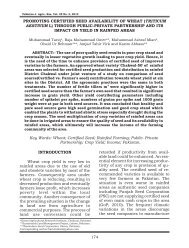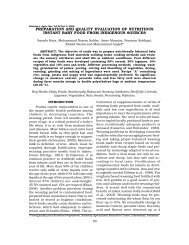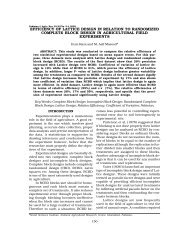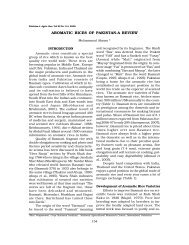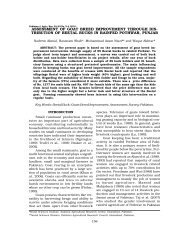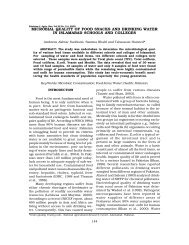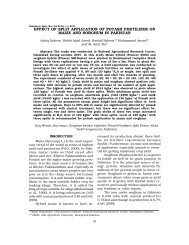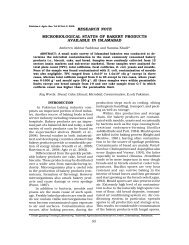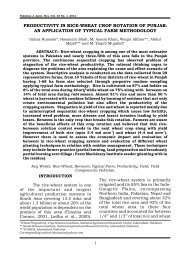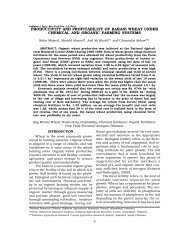chakwal sarson: a new high yielding rapeseed variety - PJAR
chakwal sarson: a new high yielding rapeseed variety - PJAR
chakwal sarson: a new high yielding rapeseed variety - PJAR
Create successful ePaper yourself
Turn your PDF publications into a flip-book with our unique Google optimized e-Paper software.
Pakistan J. Agric. Res. Vol 24 No. 1-4, 2011.<br />
CHAKWAL SARSON: A NEW HIGH YIELDING RAPESEED VARIETY<br />
Ghulam Shabbir*, Muhammad Aftab, Abid Mahmood** Muhammad Kausar Nawaz<br />
Shah* and Nasir Mahmood Cheema***<br />
ABSTRACT:- Barani Agricultural Research Institute (BARI), Chakwal has a strong<br />
breeding programme for oilseed research including Brassica crops. Long and consistent<br />
breeding efforts on Brassica improvement programme by the breeders has<br />
resulted in the development of a <strong>high</strong> <strong>yielding</strong> and drought tolerant elite line<br />
SPS-5, selected from the segregating progenies of a cross between Ganyou-4 x<br />
Westar. Breeding was carried out by the pedigree method and the elite line was<br />
evaluated for its yield potential in various yield trials conducted at BARI, Chakwal<br />
from 1994 to 1998. Based on the desirable phenotypic traits and superior seed<br />
yield, SPS-5 was approved as a <strong>rapeseed</strong> <strong>variety</strong> “Chakwal Sarson” by the Punjab<br />
Seed Council in 2002 for general cultivation in the Punjab barani tract.<br />
Key Words: Rapeseed; Cultivar; High Yielding; Bold Seeded; Drought Tolerant; Pakistan.<br />
INTRODUCTION<br />
Rapeseed and mustard are traditional<br />
oilseed crops in Pakistan and an important<br />
oilseed crop grown in different parts of the<br />
world. The oil contents range is 37-45 %. It<br />
contributes about 16-20 % towards domestic<br />
edible oils production. Rapeseed and<br />
mustard are grown on 128900ha with production<br />
of 127600t annually in the Punjab<br />
province of Pakistan. Out of which Punjab<br />
barani tract covered 24300 ha (18.56 %) and<br />
contributed 17300t (13.56 %) towards total<br />
production in the province (Anonymous,<br />
2009). An ever increasing population pressure<br />
warrants a proportionate increase in<br />
the local edible oils production. The local<br />
edible oils production can be increased by<br />
exploiting the maximum production potential<br />
of existing varieties through modern<br />
production technology and evolving <strong>new</strong><br />
varieties with <strong>high</strong> yield potential and better<br />
adapted to local agro-climatic conditions.<br />
Development of <strong>new</strong> varieties has significantly<br />
increased the ultimate production<br />
of different field crops (Sadiq et al. 1999;<br />
Haq et al., 2002; Tariq and Mahmood, 2008;<br />
Naeem-ud-Din et al., 2009 and Hussain et<br />
al., 2009). Varieties of <strong>rapeseed</strong> and mustard<br />
have been developed in Pakistan<br />
(Khan, 1978) as well as in other countries<br />
(Bengtsson, 1995; Dhillon et al. 1994;<br />
Okuyama et al. 1994; McVetty et al. 1996<br />
a,b; Rife et al., 2000; Scarth et al. 1995 a,b)<br />
according to their specific requirements.<br />
However, there is a constant need to develop<br />
<strong>new</strong> <strong>high</strong> <strong>yielding</strong> cultivars; to meet<br />
the local oil demands, to avoid vulnerability<br />
to diseases, to broaden genetic base and<br />
to enhance productivity per unit area. The<br />
major objective of plant breeder is to reduce<br />
ever increasing gap between domestic<br />
production and import of edible oil by<br />
developing oilseed cultivars that possess<br />
<strong>high</strong>er yield potential per unit area to increase<br />
the overall production. The present<br />
paper describes the development of a <strong>high</strong><br />
<strong>yielding</strong> and drought tolerant <strong>rapeseed</strong> <strong>variety</strong><br />
“Chakwal Sarson” which was approved<br />
by Punjab Seed Council in its 33 rd<br />
meeting held on November 21, 2002 for<br />
general cultivation in the Punjab barani<br />
tract.<br />
MATERIALS AND METHODS<br />
Chakwal Sarson was evaluated in<br />
yield trials conducted at BARI, Chakwal,<br />
from 1993-94 to 1997-98 under the name<br />
SPS-5. Later on, the elite line was tested<br />
in Zonal Yield trials in different ecologies<br />
during 1998-99 followed by testing in National<br />
Uniform Rapeseed Yield Trials during<br />
1999-2000 and 2000-01 at various lo-<br />
*PMAS-Arid Agriculture University Rawalpindi, Pakistan.<br />
**Barani Agricultural Research Institute, Chakwal, Pakistan.<br />
***Pakistan Agricultural Research Council, Islamabad, Pakistan.<br />
14
cations in the country. All the experiments<br />
were sown during rabi season under rainfed<br />
conditions (Table 1) following Randomized<br />
Complete Block Design. Initially the cross<br />
was attempted between Ganyou-4 x Westar<br />
during 1985-86 and F 1<br />
was raised in the<br />
following year. The elite line was selected<br />
from the F 2<br />
segregating progenies during<br />
1988-89. It was further evaluated for different<br />
parameters in different yield trials<br />
and later on in the National Uniform Rapeseed<br />
Yield Trials. The experiments were<br />
conducted following Randomized Complete<br />
Block Design with four replications maintaining<br />
a net plot size of 5m x 1.8m. The<br />
row-to-row and plant-to-plant spacings were<br />
maintained at 45 cm and 10 cm, respectively.<br />
All the agronomic / cultural practices<br />
were kept uniform for all the treatments<br />
in all experiments. Data regarding<br />
days to flowering, days to maturity, plant<br />
height, seed yield and yield related traits<br />
were recorded and analyzed statistically on<br />
the basis of mean values (Singh and<br />
Chaudhry, 2004).<br />
RESULTS AND DISCUSSION<br />
The breeding history of <strong>rapeseed</strong> <strong>variety</strong><br />
“Chakwal Sarson” tested under code<br />
SPS-5 is illustrated (Table 2). SPS-5 is an<br />
elite <strong>high</strong> <strong>yielding</strong> line selected from the<br />
segregating generation of a cross between<br />
Ganyou-4 and Westar and other promising<br />
lines on the basis of plant shape, leaf<br />
size, pod shape, seed size and seed coat<br />
color. It showed excellent adaptability under<br />
local environmental conditions. It was<br />
evaluated in a series of different yield trials<br />
from 1993-94 to 2000-01(Table 3).<br />
GHULAM SHABBIR ET AL.<br />
In preliminary yield trials conducted<br />
during 1993-94 and 1994-95 at BARI,<br />
Chakwal, 11 promising lines were evaluated<br />
against two check varieties for their<br />
yield performance wherein SPS-5 produced<br />
the <strong>high</strong>est seed yield of 2917 kgha -1 compared<br />
to Westar which gave 2257 kgha -1 and<br />
showed 29.24 % <strong>high</strong>er seed yield over the<br />
check <strong>variety</strong>. The line was again evaluated<br />
for its yield performance against two<br />
check varieties. The elite line recorded a<br />
yield increase of 7.64 % over the check <strong>variety</strong><br />
Westar.<br />
SPS-5 showed a yield increase of<br />
11.82% over the check <strong>variety</strong> Westar in<br />
Micro Yield trials conducted at BARI,<br />
Chakwal and Barani Agricultural Research<br />
Station (BARS), Fateh Jang during 1997-<br />
98. The line SPS-5 was further evaluated<br />
in Zonal Yield Trials conducted at five locations<br />
(BARI, Chakwal, Oilseeds Research<br />
Station, Khanpur, Regional Agricultural Research<br />
Institute, Bhawalpur, Ayub Agricultural<br />
Research Institute, Faisalabad and<br />
BARS, Fateh Jang) in the Punjab province<br />
to study its adaptability under a wide range<br />
of climatic conditions during 1998-99. It<br />
showed an increase of 9.01% over the<br />
check <strong>variety</strong> Westar.<br />
The elite line SPS-5 was further evaluated<br />
in National Uniform Yield Trials at<br />
nine locations throughout the country (conducted<br />
by the National Coordinator Oilseeds,<br />
National Agricultural Research Centre,<br />
Islamabad) during 1999-2000 wherein<br />
it produced an average seed yield of 1614<br />
kgha -1 against the check <strong>variety</strong> Shiralee<br />
(1419 kgha -1 ) and showed an increase of<br />
13.74 % over the check <strong>variety</strong>. SPS-5 was<br />
Table 1. Monthly rainfall data of Chakwal for rabi growing season (1993-1999)<br />
(mm)<br />
Year Jan Feb Mar Apr Sep Oct Nov Dec Total<br />
1993 10.1 15.3 60.4 37.1 157.0 0 0 0 279.9<br />
1994 22.6 25.0 8.9 48.3 15.5 12.0 0 24.0 156.3<br />
1995 1.8 39.3 108.0 72.5 7.0 15.3 0 3.5 247.4<br />
1996 51.9 62.1 81.8 5.5 27.0 60.0 0 0 288.3<br />
1997 28.0 03.0 25.4 130.0 96.9 115.0 19.0 4.0 421.3<br />
1998 21.9 159.3 20.0 96.0 35.7 44.0 0 0 376.9<br />
1999 129.7 18.6 22.3 5.0 87.6 9.3 18.0 0 290.5<br />
Avg 38.0 46.1 46.7 56.3 61.0 36.5 5.3 4.5 294.4<br />
15
CHAKWAL SARSON NEW HIGH VARIETY<br />
Table 2. Breeding history of the <strong>rapeseed</strong> <strong>variety</strong> “Chakwal Sarson”<br />
Year Filial Generation /Trial Remarks<br />
1985-86 Hybridization Cross “Ganyou-4 x Westar”was attempted<br />
1986-1987 F 1<br />
The F 0<br />
seed was planted to raise F 1<br />
1987-1988 F 2<br />
Seed was space planted and selections<br />
were made<br />
1988-1989 to<br />
1992-1993 F 3<br />
to F 6<br />
Generations were advanced and selection<br />
on the basis of desirable traits were made<br />
till uniformity was achieved in the progeny<br />
lines<br />
1993-1994 to<br />
1994-1995 Evaluation in trials Evaluated SPS-5 in preliminary yield trials at<br />
BARI, Chakwal<br />
1995-1996 to<br />
1996-1997 Evaluation in trials Evaluated SPS-5 in Advanced Lines Yield<br />
trials at BARI, Chakwal<br />
1997-1998 Evaluation in trials Evaluated SPS-5 in Micro Yield Trials<br />
1998-1999 Evaluation in trials Evaluated SPS-5 in sowing date, plant spacing<br />
and multi-location yield trials<br />
1999-2000 to<br />
2000-2001 Evaluation in trials Evaluated SPS-5 in National Uniform Yield<br />
trials at different locations in the country<br />
2002 Approval as <strong>variety</strong> Approved as commercial <strong>variety</strong> “Chakwal<br />
Sarson” by Punjab Seed Council for general<br />
cultivation in Punjab barani tract<br />
Table 3. Mean seed yield performance of SPS-5 compared to recommended varieties<br />
of <strong>rapeseed</strong> in various yield trials<br />
(kgha -1 )<br />
Year Trial No. of trials SPS-5 Westar Shiralee<br />
1993-94 & Preliminary<br />
1994-95 Yield Trial 2 2917 2257 -<br />
1994-95 & Regular<br />
1996-97 Yield Trial 2 2213 2056 -<br />
1997-98 Micro<br />
Yield Trial 2 1864 1667 -<br />
1998-99 Sowing Date 1 1541 1273 -<br />
1998-99 Row Spacing 1 1884 1492 -<br />
1998-99 Zonal Yield<br />
Trial 5 1307 1199 -<br />
1999-2000 National<br />
Uniform<br />
Yield Trial 9 1614 - 1419<br />
2000-01 National<br />
Uniform<br />
Yield Trial 7 1475 - 1343<br />
Total/ Mean 29 1852 1657 1381<br />
% Increase over check varieties - + 11.8 +34.1<br />
16
GHULAM SHABBIR ET AL.<br />
Table 4. Average seed yield as affected by various sowing dates and genotypes<br />
during 1998-99 ( kgha -1 )<br />
Sr.No. Cultivar Sep.15 Oct.1 Oct.15 Nov.1 Nov15 Mean<br />
1 SPS-5 1674 1852 1778 1259 1141 1541<br />
2 6008 1630 1744 1659 1178 1133 1469<br />
3 Westar 1407 1484 1474 1007 983 1273<br />
Mean 1570 1693 1637 1148 1086<br />
Cd1 18.48<br />
Cd2 26.89<br />
CV (%) 1.98<br />
Table 5. Seed yield as influenced by<br />
various genotypes and row<br />
spacings (1998-99)<br />
(kgha -1 )<br />
Row SPS-5 6008 Westar Mean<br />
spacing<br />
(cm)<br />
30 1870 1804 1476 1717<br />
45 1985 1859 1634 1803<br />
60 1798 1670 1434 1634<br />
Mean 1884 1778 1492<br />
Cd 126.19<br />
Cd2 36.19<br />
CV (%) 2.49<br />
again tested in National Uniform Yield Trials<br />
at seven locations during 2000-01<br />
wherein it produced an average yield of<br />
1475 kgha -1 against check <strong>variety</strong> Shiralee<br />
(1343 kgha -1 ) and showed a yield increase<br />
of 9.83% over the check <strong>variety</strong>. On an average<br />
of two years of NUYT results, SPS-5<br />
produced <strong>high</strong>er seed yield (1545 kgha -1 )<br />
against check <strong>variety</strong> Shiralee (1381<br />
kgha -1 ) thus recording a yield increase of<br />
11.88% which showed its inherent capability<br />
to produce <strong>high</strong>er seed yield over the<br />
check <strong>variety</strong> Shiralee. On an average of<br />
29 yield trials conducted from 1993-94 to<br />
2000-01, SPS-5 gave 11.8% and 34.1%<br />
<strong>high</strong>er seed yield than commercial varieties<br />
viz., Westar and Shiralee, respectively.<br />
Agronomic trials conducted to find out<br />
the best sowing time for the elite line, revealed<br />
that SPS-5 produced the maximum<br />
mean seed yield (1693 kgha -1 ) when planted<br />
on October 1 followed by sowing on October<br />
15 (Table 4). Hence the most appropriate<br />
planting time of Chakwal Sarson to get<br />
<strong>high</strong>er yield was October 1-15 . Another<br />
trial conducted to find out the best row spacing<br />
showed that the elite line gave maximum<br />
mean yield (1803 kgha -1 ) when the<br />
crop was planted at a row spacing of 45 cm<br />
followed by a row spacing of 30 cm<br />
(Table 5)<br />
The <strong>rapeseed</strong> genotype was developed<br />
through conventional breeding following<br />
pedigree method. Various cultivars already<br />
developed through conventional breeding<br />
in field crops have significantly contributed<br />
towards the overall productivity of respective<br />
crop in the country both in rainfed and<br />
irrigated areas.<br />
Keeping in view the inherent capability<br />
of the elite line ‘SPS-5’ a proposal for<br />
the approval of SPS-5 as “Chakwal Sarson”<br />
was prepared and submitted to the Punjab<br />
Seed Council. The PSC approved the elite<br />
line SPS-5 as a <strong>rapeseed</strong> <strong>variety</strong> “Chakwal<br />
Sarson” in its 33 rd meeting held on November<br />
21, 2002 for general cultivation in the<br />
Punjab barani tract. Its cultivation on large<br />
scale will not only increase the overall<br />
profit of the grower but also increased productivity<br />
will help to enhance domestic edible<br />
oil production in the country.<br />
LITERATURE CITED<br />
Anonymous. 2009. Agricultural Statistics<br />
of Pakistan, Ministry of Food, Agriculture<br />
& Livestock, Islamabad, Government<br />
of Pakistan.<br />
Bengtsson, A. 1995. Bristol, Express and<br />
Lipora – <strong>new</strong> winter rape varieties.<br />
Sveriges Lantbruksuniversitet, 64(6/7):<br />
13-14.<br />
Dhillon, S. S. Kaur, S. Brar, B.K. Gupta, M.L.<br />
Baldev, S. Banga, S. K. and Labana, K.S.<br />
1994. PTB 37- A <strong>new</strong> <strong>variety</strong> of toria<br />
(Brassica campestris). J. Res. Punjab<br />
17
Agricultural University, 31(3): 392.<br />
Haq, M.A. Sadiq M. and Hassan, M. Shah,<br />
T. M. and Ali, H. 2002. CM- 2000 – A <strong>new</strong><br />
kabuli chickpea <strong>variety</strong>. Pakistan J.<br />
Seed Tech. 1(1): 45-49.<br />
Hussain, M. Hussain, M. Khan, S. Anwar,<br />
J. and Akbar, M. 2009. Faisalabad-08: A<br />
New High Yielding and Disease Resistant<br />
Wheat Variety. J. Agric. Res. 47((4):<br />
365-374.<br />
Khan, S.A. 1978. Poorbi Raya: A <strong>new</strong> <strong>high</strong><br />
<strong>yielding</strong> <strong>variety</strong> maturing in as many<br />
days as toria, for zaid kharif sowings.<br />
Proceedings of first National Oilseeds<br />
Seminar, held at Punjab Agri. Res. Instt.,<br />
Lyallpur, May 16-17, 1975. p. 94-109.<br />
Okuyama, Y. Shibata, M. Endo, T.<br />
Sugawara, S. Hiraiwa, S. and Kaneko, I.<br />
1994. A <strong>new</strong> zero erucic rape <strong>variety</strong><br />
“Kizakinonatane”. Bulleitin of the<br />
Tohoku National Agricultural Experiment<br />
Station, 88: 1-13.<br />
Mc Vetty, P.B.E. Scarth, R. Rimmer, S.R.<br />
Berg C.G. and Van Den, J. 1996a. Venus<br />
<strong>high</strong> erucic, low glucosinolate summer<br />
rape. Can. J. Pl. Sci. 76(2): 341-<br />
342.<br />
Mc Vetty, P.B.E. Rimmer, S.R. Scarth, R.<br />
Berg C.G. and Van Den, J. 1996b. Neptune<br />
<strong>high</strong> erucic, low glucosinolate summer<br />
rape. Can. J. Pl. Sci. 76(2): 343-344.<br />
Naeem-ud-Din, A. Mahmood, G.S.S.<br />
CHAKWAL SARSON NEW HIGH VARIETY<br />
Khattak, I. S. and Shah, F.H. 2009. High<br />
<strong>yielding</strong> Arachis hypogaea <strong>variety</strong><br />
“Golden”. Pakistan J. Bot. 41(5): 2217-<br />
2222.<br />
Rife, C.L. Alud, D.L. Stegmeier, W.D.<br />
Sunderman, H.D. Heer, W.F.<br />
Baltensperger, D.D. Nelson, L.A.<br />
Johnson, D.L. Bordovsky, D. and Minor,<br />
H.C. 2000. Registration of “Plainsman”<br />
Rapeseed. Crop Sci. 40(1): 292-294.<br />
Sadiq, M.S. Sarwar, G. and Khattak, G.S.S.<br />
1999. NIAB MUNG -98: A diverse, <strong>high</strong><br />
<strong>yielding</strong>, and disease resistant<br />
mungbean <strong>variety</strong>. Pakistan J. Biol. Sci.<br />
2(2): 455-458.<br />
Scarth, R. Rimmer, S.R. and Mc Vetty,<br />
P.B.E. 1995a. Appolo low lenolenic summer<br />
rape. Can. J. Pl. Sci. 75(1): 203-<br />
204.<br />
Scarth, R. and Mc Vetty, P.B.E. Rimmer,<br />
S.R. 1995b. Mercury <strong>high</strong> Erucic low<br />
Glucosinolate summer rape. Can. J. Pl.<br />
Sci. 75(1): 205-206.<br />
Singh, R. K. and Chaudhry, B.D. 2004. Biometrical<br />
methods in quantitative genetic<br />
analysis. Kalyani Publishers,<br />
Ludhiana, India, 318 p.<br />
Tariq, M.A. and Mahmood, A. 2008.<br />
Chakwal Mung-6, A <strong>high</strong> <strong>yielding</strong><br />
boldseeded and disease resistant <strong>variety</strong><br />
of mungbean. J. Agric. Res. 46(3):<br />
309-314.<br />
18




